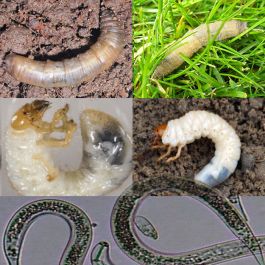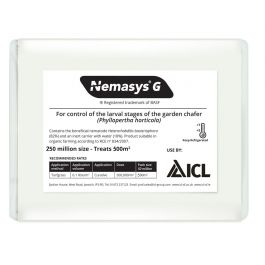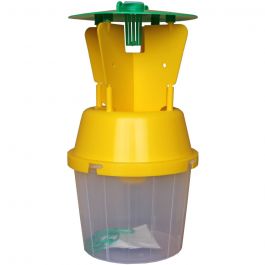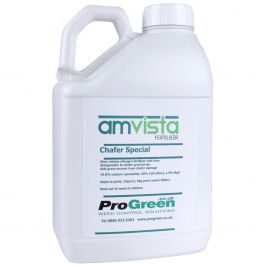Chafer Grub Treatment
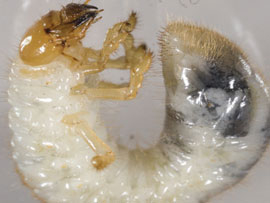
A chafer grub infestation can quickly transform a prestige lawn or an area of prized turf into a ploughed field.
Page Contents
 Key Facts:
Key Facts:
- Common names: Chafer grubs, mainly garden chafer and welsh chafer
- Scientific names: Phyllopertha horticolaand & Hoplia philanthus
- Plants affected: Lawns & Turf (can also feed on trees, shrubs and nursery stock)
- Main symptoms: Scruffy turf with pieces pulled up by birds and animals searching for the grubs
- Most active: Grubs: September-April; Adult beetles: May-June
Have you got a chafer beetle problem?
The grubs live in the soil, emerging from eggs in July to feed on the roots of grass during late Summer/Autumn. They then reappear in Spring to continue feeding until emerging as fully grown chafer beetles or chafer bugs in mid May - June. Further damage to lawns is caused by crows, foxes and badgers who tear up the grass to look for these grubs during the months when the grubs are active.
What are chafer grubs?
Chafer Grubs: These are young maggot-like larvae before they hatch into chafer beetles. Chafer beetles are commonly one of two types: the Garden Chafer and Cockchafer. The Garden Chafer has an annual lifecycle whereas the Cockchafer is larger and more destructive because it lives in the soil for 3 years, eating roots, before it hatches. They live near the soil surface and will only burrow deeper once autumn temperatures start to drop.
Chafer Grub Damage
The chafer grub larvae can cause a lot of damage to the lawn especially if there are large numbers of them. The grubs feed on the roots of the grass which results in damage being caused which can largely be seen during the autumn and spring when the grubs are reaching maturity. Patches of the lawn can become yellow from where the roots have been eaten. Alongside this further damage is caused is caused by crows, foxes and badgers who tear up the grass to look for these grubs during the months when the grubs are active.
How to get rid of chafer grubs
How to kill chafer grub larvae
Effective biological control can be achieved using Nematodes (microscopic worms) which go out and actively hunt down chafer grub larvae. These nematodes are carriers of bacteria which is harmful to the chafer grub larva. These natural non-pesticide alternatives are completely safe to humans and pets with no exclusion period after application.
Chafer Grub Killer
Use Nemasys G to control the chafer larvae with convenient 100m2 or 500m2 packs sizes available.
Detailed information on how to deatil with Chafer Grubs can be found in this downloadable guide.
To view our Chafer Grub Treatment Calendar, click here
Maximise your control:
- It is important that soil temperatures 12oC or higher to support nematode activity. Soil temperatures can be accurately measured by using a soil probe thermometer
- Nemasys G can be used any time of the year, when the larvae are active, subject to soil temperatures being over 12oC. Larvae are at their smallest and nearest the soil surface in August and September and easiest to control at that time.
- Soils should be moist both before, during and after application of Nemasys products for effective results. Application applied during the rain are very effective and early morning or evening applications are preferred.
- When removing from a fridge, allow the nematodes top reach room temperature before application to avoid “shocking” the nematodes.
- High levels of thatch in the turf can also be detrimental by preventing nematodes reaching the soil. Thatch levels can be reduced by standard cultural and physical methods such as scarifying and also helped by using products such as Amvista Thatch GO
- Adult Chafer Beetle are active in May and June. There acticity can serve as an initial and ongoing risk assessment of future, potential chafer damage can be monitored by using an adult Chafer beetle trap. These traps are useful in two ways. Firstly by directly reducing the number of eggs laid by the adult beetles. This can be significant, as each female adult can lay up to 50 eggs. Secondly, the catch counts will indicate the likely ongoing risk from autumn grub damage. Note, that egg laying can take place soon after the first adults flights. Chafer Traps can be set in position from the second/third week of May.
- As an extra integrated control measure, there is now evidence that treating the affected lawn or turf with a slow release, nitrogen based fertiliser containing calcium cyanamide, aids recovery of chafer damaged lawns and turf by the metabolites damaging the chafer grub larvae such Amvista Chafer Special.
FAQS
How to apply Nemasys chafer grub killer?
Simply mix the Nemasys G powder with water at the given specifications and apply the solution to your lawn.
When should I treat my lawn for chafer grubs?
You can apply Nemasys G anytime during the year, but you must ensure that the soil temperature is at least 12℃ or higher for the best results.

